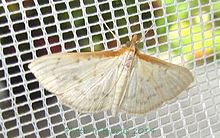
Asclepias tuberosa, commonly known as butterfly weed, is a species of milkweed native to eastern and southwestern North America. It is commonly known as butterfly weed because of the butterflies that are attracted to the plant by its color and its copious production of nectar.

Pentatomidae is a family of insects belonging to the order Hemiptera, generally called shield bugs or stink bugs. Pentatomidae is the largest family in the superfamily Pentatomoidea, and contains around 900 genera and over 4700 species. As hemipterans, the pentatomids have piercing sucking mouthparts, and most are phytophagous, including several species which are severe pests on agricultural crops. However, some species, particularly in the subfamily Asopinae, are predatory and may be considered beneficial.

Orthonama obstipata, the gem, is a moth of the family Geometridae. The species was first described by Johan Christian Fabricius in 1794. It is a cosmopolitan species. In continental Europe though in the northeast, its range does not significantly extend beyond the Baltic region and it is absent from northern Russia. This well-flying species is prone to vagrancy and able to cross considerable distances of open sea; it can thus be regularly found on the British Isles and even on Iceland.

Merodon is a large genus of bee-like hoverflies. The majority of the species are centered on the Mediterranean and it is the second largest hoverfly genus in Europe with more than 50 European species. It is distributed over the Palaearctic and Afrotropical realms, with most European species occurring in Southern and Eastern Europe. The centre of distribution of this genus appears to be Turkey, where about 65 species have been recorded. Some species occur in Africa and the middle East, as far as Pakistan. Given the rate at which new species have been recorded over the past decades, the worldwide number of species could exceed 200. The larvae feed on the bulbs or rhizomes of monocotyledons.

Mocis repanda, the striped grass looper, is a species of moth of the family Erebidae. It was described by Johan Christian Fabricius in 1794. It is found in Central America and the Caribbean, including Cuba, the Dominican Republic, Guadeloupe, Guatemala, Jamaica, Puerto Rico and Saint Thomas. Strays can be found in the United States, up to southern Texas as well as subtropical Africa south of the Sahara, including the islands of the Indian Ocean.

Prochoreutis myllerana, Miller’s nettle-tap or small metal-mark, is a moth of the family Choreutidae found in Asia and Europe. Miller's nettle-tap was first described by Johan Christian Fabricius in 1794 from a specimen found in Sweden.

Oraesia emarginata is a species of moth of the family Erebidae first described by Johan Christian Fabricius in 1794. It is found in Australia, New Caledonia, Indonesia, New Guinea, Pakistan, the Philippines, India, Sri Lanka, Sulawesi, Taiwan, China, Japan, Korea and Nepal as well as Eritrea, Ethiopia, Kenya, Namibia, Nigeria, South Africa, Tanzania, the Gambia, Uganda, Oman and Yemen.

Phymateus is a genus of fairly large grasshoppers of the family Pyrgomorphidae, native to shrubland, semi-deserts, savanna, woodland, gardens and cultivated areas in Sub-Saharan Africa, with ten species in the African mainland and two species in Madagascar. Some species have bright aposematic colours and are highly toxic.

Miris is genus of true bugs belonging to the family Miridae, subfamily Mirinae. The genus was first described in 1794 by Johan Christian Fabricius.

Amyna punctum is a moth of the family Noctuidae first described by Johan Christian Fabricius in 1794. This moth can be found throughout subtropical African countries such as South Africa, Madagascar and Australasian countries like India, Sri Lanka, the Philippines, Borneo and the Andaman Islands.

Diaphania costata, the orange-shouldered sherbet moth or erroneously the white palpita moth, is a moth of the family Crambidae. The species was first described by Johan Christian Fabricius in 1794. It is widely dispersed, being found in the Indomalayan realm, as well as Europe. It is also found in Mexico and Texas, possibly having been introduced accidentally.

Eriopygodes imbecilla, the Silurian, is a moth of the family Noctuidae first described by Johan Christian Fabricius in 1794.

Saldula pallipes is a species of shore bug in the family Saldidae. It is found in Africa, the Caribbean, Europe and Northern Asia, Central America, North America, and South America.

Chalcosyrphus (Xylotomima) piger, the short-haired leafwalker, is an uncommon species of syrphid fly found throughout North America and Europe. Hoverflies get their names from the ability to remain nearly motionless while in flight. The adults are also known as flower flies, for they are commonly found around and on flowers, from which they get both energy-giving nectar and protein-rich pollen. Larvae have been identified from sappy hollows from Larix and Pinus.

Epinotia abbreviana is a moth of the family Tortricidae. It is found in Europe and was first described by Johan Christian Fabricius in 1794.















